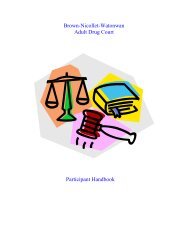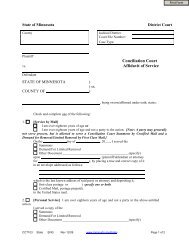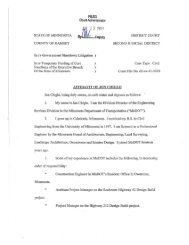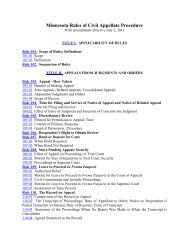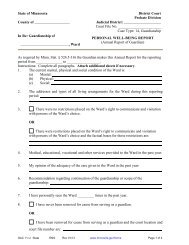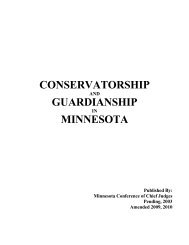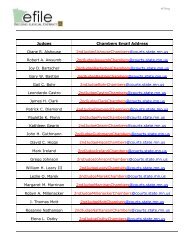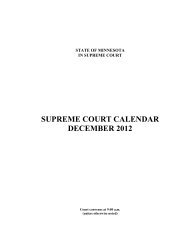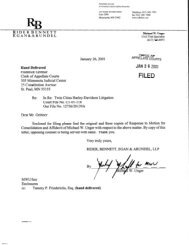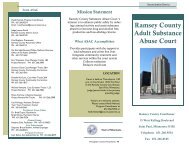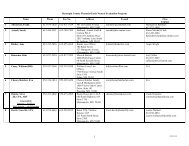1989-03-24 Comments of Star Tribune.pdf - Minnesota Judicial Branch
1989-03-24 Comments of Star Tribune.pdf - Minnesota Judicial Branch
1989-03-24 Comments of Star Tribune.pdf - Minnesota Judicial Branch
Create successful ePaper yourself
Turn your PDF publications into a flip-book with our unique Google optimized e-Paper software.
Chapter 7<br />
CAMERAS IN COURT<br />
I. INTRODUCTION<br />
A permanent rule permitting film and electronic<br />
media coverage <strong>of</strong> court proceedings was adopted by<br />
the <strong>Judicial</strong> Council effective July 1,19&I. The council’s<br />
action was taken fOlIOwing an experimental peri.<br />
od <strong>of</strong> film and electronic media coverage which<br />
bcgnn July 1, 1980. During that period, the council<br />
received many comments and a consultant’s report<br />
that assessed the results <strong>of</strong> the first year <strong>of</strong> the expe+<br />
ment.’<br />
New rule 980 <strong>of</strong> the California Rules <strong>of</strong> Court replaces<br />
former rules 980 through 980.3 and incorpo.<br />
rates the following provisions <strong>of</strong> the prior experimental<br />
rules:<br />
(1) Courtroom photography and recording is permitted,<br />
subject to the consent <strong>of</strong> the judge and any<br />
restrictions the court might impose in order to protect<br />
the rights <strong>of</strong> the litigants, preserve the dignity <strong>of</strong><br />
the court, and prevent disruption <strong>of</strong> the proceedings.<br />
(2) Unauthorized use <strong>of</strong> photographs, recordings<br />
The council’s action culminated a five and a half<br />
year process during which the question <strong>of</strong> film and<br />
electronic media coverage <strong>of</strong> court proceedings was<br />
considered by a special committee, an experimental<br />
rule was adopted, and the effect <strong>of</strong> film and electron-<br />
ic media coverage was reviewed.<br />
The process began on December 2,1978, when the<br />
council, acting on the recommendation <strong>of</strong> its Appel-<br />
late Court Committee, adopted the following resolu-<br />
tion:<br />
That the <strong>Judicial</strong> Council approve a one-year ex-<br />
perimental program to permit broadcasting and<br />
photographing <strong>of</strong> court proceedings in selected<br />
courts with the consent <strong>of</strong> the judge and the par-<br />
ties and without cost to the <strong>Judicial</strong> Council or the<br />
courts. To this end it is recommended that an advi-<br />
sory committee <strong>of</strong> judges, lawyers, media repre-<br />
sentatives and citizens be appointed to develop a<br />
proposed program, together with a draft <strong>of</strong> neces-<br />
sary rules and suggested evaluation procedures,<br />
for presentation-to the <strong>Judicial</strong> Council for its con-<br />
sideration. Among other matters, the advisory<br />
committee should consider whether the consent <strong>of</strong><br />
witnesses, jurors, or counsel for criminal defend-<br />
ants should be required.’<br />
The Chief Justice, pursuant to this resolution,<br />
appointed a 28.member Special Committee on the<br />
II. ONE-YEAR EXPERIMENT APPROVED<br />
23<br />
or transmissions is an unlawful interference with the<br />
proceedings <strong>of</strong> the court.<br />
(3) Coverage is prohibited <strong>of</strong> chambers proceed-<br />
ings; jury selection; closeups <strong>of</strong> jury members; con-<br />
versations between attorney and client, witness, or<br />
aide; conversations between attorneys; and confer-<br />
ences at the bench.<br />
(4) All restrictions found in the prior rules apply.<br />
The new rule also incorporates the existing author-<br />
ization for personal tape recorders in court used sole-<br />
ly for note-taking purposes (old rule 980 (f) , now rule<br />
980(c)).<br />
The permanent rule continues the requirement<br />
that application for the judge’s consent be on a form<br />
approved by the <strong>Judicial</strong> Council. A new form, which<br />
simplifies the old form and includes an order, was<br />
adopted by the council at the same time as it adopted<br />
the permanent rule.<br />
Courts and the Media. The committee, appointed<br />
in January, 1979, included representatives <strong>of</strong> tele-<br />
vision, radio, photographic, and newspaper jour-<br />
nalism; judges; prosecution, defense, and other<br />
attorneys; and the publica<br />
Following a number <strong>of</strong> meetings, the committee<br />
recommended a statewide experiment permitting<br />
film and electronic media coverage <strong>of</strong> courtroom<br />
proceedings under specified conditions and upon<br />
consent <strong>of</strong> the judge and the parties.’ The council,<br />
after circulating the draft rules for comment,<br />
adopted a one-year experiment contingent upon<br />
the consent <strong>of</strong> the judge and, in criminal cases, the<br />
parties.s<br />
The council originally had decided to dispense<br />
with the requirement <strong>of</strong> party consent in all cases.<br />
However, on April 21, 1980, the United States Su-<br />
preme Court noted probable jurisdiction in Chars-<br />
dler v. Florida 6 on the subject <strong>of</strong> whether<br />
television coverage <strong>of</strong> a criminal trial over the Ob<br />
jection <strong>of</strong> the defendant violated the defendant’s<br />
rights <strong>of</strong> due process and fair trial.<br />
Effective January 31, 1981, after the decision in<br />
Chandler that party consent to television coverage<br />
is not necessarily required in criminal cases,’ rule<br />
989.2 was amended to permit coverage <strong>of</strong> criminal<br />
cases without the consent <strong>of</strong> the parties.O



